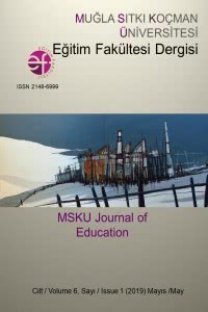Ergenlerde Üstbiliş ve Sınav Kaygısı Arasındaki İlişkide Ruminasyon ve Bilişsel Esnekliğin Aracılık Rolü
Bu çalışmanın amacı sınav kaygısı, üstbiliş, ruminasyon ve bilişsel esneklik arasındaki doğrudan ve dolaylı ilişkileri incelemektir. Çalışmaya toplam 504 orta öğretim son sınıf öğrencisi katılmıştır. Katılımcılar amaçlı örnekleme yöntemiyle belirlenmiştir. Çalışmada veri toplamak için Sınav Kaygısı Envanteri, Üstbiliş Ölçeği Çocuk Ergen Formu, Ruminasyon Ölçeği Kısa Formu, Bilişsel Esneklik Ölçeği ve Kişisel Bilgi Formu kullanılmıştır. Verilerin analizi SPSS 20.0 ve AMOS 22.0 programları kullanılarak gerçekleştirilmiştir. Değişkenler arasındaki ilişkiler Pearson momentler çarpımı korelasyon katsayısı yöntemi ile belirlenmiş olup sınav kaygısı, üstbiliş, ruminasyon ve bilişsel esneklik arasındaki doğrudan veya dolaylı ilişkiler, Yapısal Eşitlik Modeli yöntemi kullanılarak test edilmiştir. Ayrıca verilerin analizinde betimsel istatistiksel yöntemleri kullanılmıştır. Yapısal Eşitlik Modeli çerçevesinde elde edilen bulgulara göre, ruminasyon ve bilişsel esneklik üstbiliş ve sınav kaygısı arasındaki ilişkide aracık rolü üstlenmektedir. Diğer taraftan bilişsel esneklik, ruminasyon ve sınav kaygısı arasındaki ilişkide aracılık rolü üstlenmektedir. Araştırmada elde edilen bulgular, ilgili literatür çerçevesinde tartışılmış, araştırmacı ve uygulamacılara yönelik önerilerde bulunulmuştur.
The Mediating Role of Rumination and Cognitive Flexibility in The Relationship Between Metacognition and Test Anxiety in Adolescents
This study aims to examine the direct and indirect relationships among test anxiety, metacognition, rumination, and cognitive flexibility. A total of 504 secondary school students participated in the study. The participants were identified through purposive sampling method. Test Anxiety Inventory, Metacognition Scale Child Adolescents Form, Rumination Scale Short Form, Cognitive Flexibility Scale, and Personal Information Form were used to gather data. Data were analyzed by using SPSS 20.0 and AMOS 22.0. Relationships among variables were determined by Pearson product-moment correlation coefficient method; the direct or indirect relationships among test anxiety, metacognition, rumination, and cognitive flexibility were tested using the Structural Equation Model method. Besides, descriptive statistical methods were used in the analysis of the data. Findings from Structural Equational Model analysis suggest that rumination and cognitive flexibility mediate the relationship between metacognition and test anxiety. Further, findings indicated that cognitive flexibility also plays a mediating role in the relationship between rumination and test anxiety. The study's findings were discussed within the framework of relevant literature, and suggestions were made for researchers and practitioners.
___
- Wells, A. (2000). Emotional Disorders and Metacognition. New York; Wiley.
- Wells, A. (2011). Metacognitive therapy for anxiety and depression. Newyork: Guilford press.
- Wells, A., & Matthews, G. (1996). Modelling cognition in emotional disorder: The S-REF model. Behaviour Research and Therapy, 34(11-12), 881-888. doi:10.1016/s0005-7967(96)00050-2
